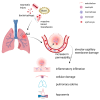Dual Roles of Hypoxia-Inducible Factor 1 in Acute Lung Injury: Tissue-Specific Mechanisms and Therapeutic Modulation
- PMID: 40710342
- PMCID: PMC12293812
- DOI: 10.3390/cells14141089
Dual Roles of Hypoxia-Inducible Factor 1 in Acute Lung Injury: Tissue-Specific Mechanisms and Therapeutic Modulation
Abstract
Acute lung injury (ALI), a life-threatening clinical syndrome with multifactorial origins, is characterized by uncontrolled pulmonary inflammation and disrupted alveolar-capillary barrier integrity, leading to progressive hypoxemia and respiratory failure. In this hypoxic setting, hypoxia-inducible factor (HIF)-1 is activated, acting as a central regulator of the inflammatory response and reparative processes in injured lung tissue during ALI. The role of HIF-1 is distinctly dualistic; it promotes both anti-inflammatory and reparative mechanisms to a certain extent, while potentially exacerbating inflammation, thus having a complex impact on disease progression. We explore the latest understanding of the role of hypoxia/HIF-mediated inflammatory and reparative pathways in ALI and consider the potential therapeutic applications of drugs targeting these pathways for the development of innovative treatment strategies. Therefore, this review aims to guide future research and clinical applications by emphasizing HIF-1 as a key therapeutic target for ALI.
Keywords: acute lung injury; hypoxia; hypoxia-inducible factors; inflammation; regulation; tissue repair.
Conflict of interest statement
The authors declare no conflicts of interest.
Figures





Similar articles
-
Partial liquid ventilation for preventing death and morbidity in adults with acute lung injury and acute respiratory distress syndrome.Cochrane Database Syst Rev. 2013 Jul 23;2013(7):CD003707. doi: 10.1002/14651858.CD003707.pub3. Cochrane Database Syst Rev. 2013. PMID: 23881653 Free PMC article.
-
Systemic Inflammatory Response Syndrome.2025 Jun 20. In: StatPearls [Internet]. Treasure Island (FL): StatPearls Publishing; 2025 Jan–. 2025 Jun 20. In: StatPearls [Internet]. Treasure Island (FL): StatPearls Publishing; 2025 Jan–. PMID: 31613449 Free Books & Documents.
-
Investigation of the effect and mechanism of Fei Re Pu Qing powder in treating acute lung injury (ALI) by modulating macrophage polarization via serum pharmacology and network pharmacology.J Ethnopharmacol. 2025 Jul 24;351:120089. doi: 10.1016/j.jep.2025.120089. Epub 2025 Jun 9. J Ethnopharmacol. 2025. PMID: 40499803
-
M1 Macrophage-Targeted Curcumin Nanocrystals with l-Arginine-Modified for Acute Lung Injury by Inhalation.J Pharm Sci. 2024 Aug;113(8):2492-2505. doi: 10.1016/j.xphs.2024.05.011. Epub 2024 May 19. J Pharm Sci. 2024. PMID: 38772450
-
Hypoxia-inducible factor 1alpha and vascular endothelial growth factor in Glioblastoma Multiforme: a systematic review going beyond pathologic implications.Oncol Res. 2024 Jul 17;32(8):1239-1256. doi: 10.32604/or.2024.052130. eCollection 2024. Oncol Res. 2024. PMID: 39055895 Free PMC article.
References
Publication types
MeSH terms
Substances
LinkOut - more resources
Full Text Sources

